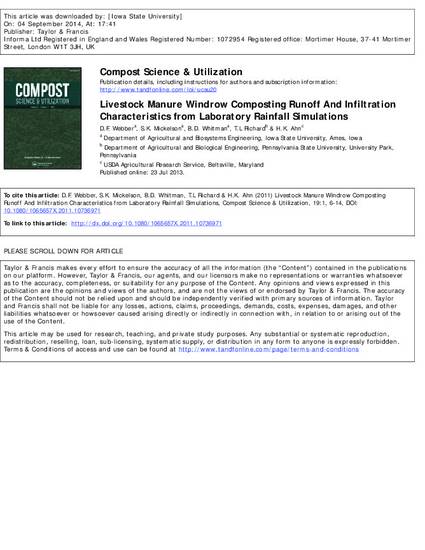
Windrow-composted livestock manure has been shown to be less hazardous to the environment compared to manure directly applied to cropland and other agricultural areas. Although offsite contaminant losses through runoff and leaching can occur during the composting process, these losses are suspected to increase under different compost moisture conditions and as composted materials mature. This research quantified the effects of windrow-composted livestock manure and straw bedding components on runoff and infiltration characteristics from laboratory rainfall simulations. Compost samples collected on three dates at approximately the beginning (day 0), middle (day 30), and end (day 60) of a June-July 2004 field research windrow composting period were used for this rainfall simulation study. Replicated compost windrow-shaped cross-section samples were constructed in a specially-designed Plexiglas container apparatus for viewing and recording infiltrated leachate wetting front position boundary movement from simulated rainfall events. Runoff and leachate samples were collected and analyzed for drainage volumes and concentrations and total mass losses of sediment, nitrate-nitrogen (NO3-N), and ortho-phosphorus (PO4-P) during and following rainfall simulation trials. Leachate wetting front position boundary movement was significantly lower for day 60 compost samples compared among day 0 and day 30 compost sample material. Drainage volume analysis results indicated significantly higher average runoff versus leachate volumes within all compost sampling dates, and runoff volumes were significantly higher among day 30 and day 60 compost samples compared to runoff volumes from day 0 compost samples. Average sediment, NO3-N, and PO4-P concentrations were significantly higher in leachate versus runoff within all compost sampling dates. Conversely, the total mass losses of these contaminants were significantly higher in runoff compared to leachate within all compost sampling dates. Results of this study suggest that biological and mechanical functions of the composting process reduced compost sample aggregates and increased compost bulk density. We hypothesize that these changes in compost material structure and porosity volume decreased infiltration and increased runoff sediment, NO3-N, and PO4-P losses during the second and final compost sampling stages of a field windrow composting period.
Available at: http://works.bepress.com/steven_mickelson/51/

This article is from Compost Science & Utilization 19 (2011): 6–14, doi:10.1080/1065657X.2011.10736971.